At a glance
Expert’s Rating
Pros
- Silky, musical sound
- Dolby Atmos support
- Built-in Alexa and Google Assistant
- AirPlay 2 and Chromecast
- Room correction
Cons
- Height and surround cues are quite subtle
- Reflective glass top
Our Verdict
The Bose Smart Soundbar 900 packs a bevy of features and superb sound, but we suspect its full immersive potential can only be unlocked with more speakers.
Price When Reviewed
$899
Best Prices Today
$899.00
Free

$899.99
Free
Packed to the gills with features, including Dolby Atmos support, room correction software, AirPlay 2 and Chromecast, and built-in Alexa and Google Assistant, the Bose Smart Soundbar 900 dishes out full-bodied, textured, and judiciously tuned sound from its nine-driver array. But while this all-in-one soundbar is a pleasure to listen to, it lacks the immersion and dynamics of its less-subtle competitors, meaning your reaction to the Smart Soundbar 900 might be more of an “ahhh” than a “wow!”
Luckily, this Bose soundbar can be augmented with additional speakers, and I suspect the Smart Soundbar 900’s immersive potential might be unlocked when it’s paired with a Bose subwoofer and surround modules. Of course, doing so will up the price tag of an already pricey ($899) component, but there are worse things than investing in the rich (no pun intended) Bose ecosystem.
This review is part of TechHive’s coverage of the best soundbars. Click that link to read reviews of competing products, along with a buyer’s guide to the features you should consider when shopping.
Configuration
The all-in-one Bose Smart Soundbar 900 comes with a total of nine drivers packed into its sleek chassis. Four oval-shaped 4 x 2-inch full-range transducers and a 1-inch tweeter supply audio for the left, right, and center channels, while a pair of 1-inch “PhaseGuide”-enabled tweeters are designed to “project sound in the room,” according to Bose. Finally, two upfiring, 4 x 2-inch oval dipole transducers bounce Dolby Atmos height cues off the ceiling, an alternative to height speakers in your ceiling. Each driver is powered by its own Class-D amplifier.
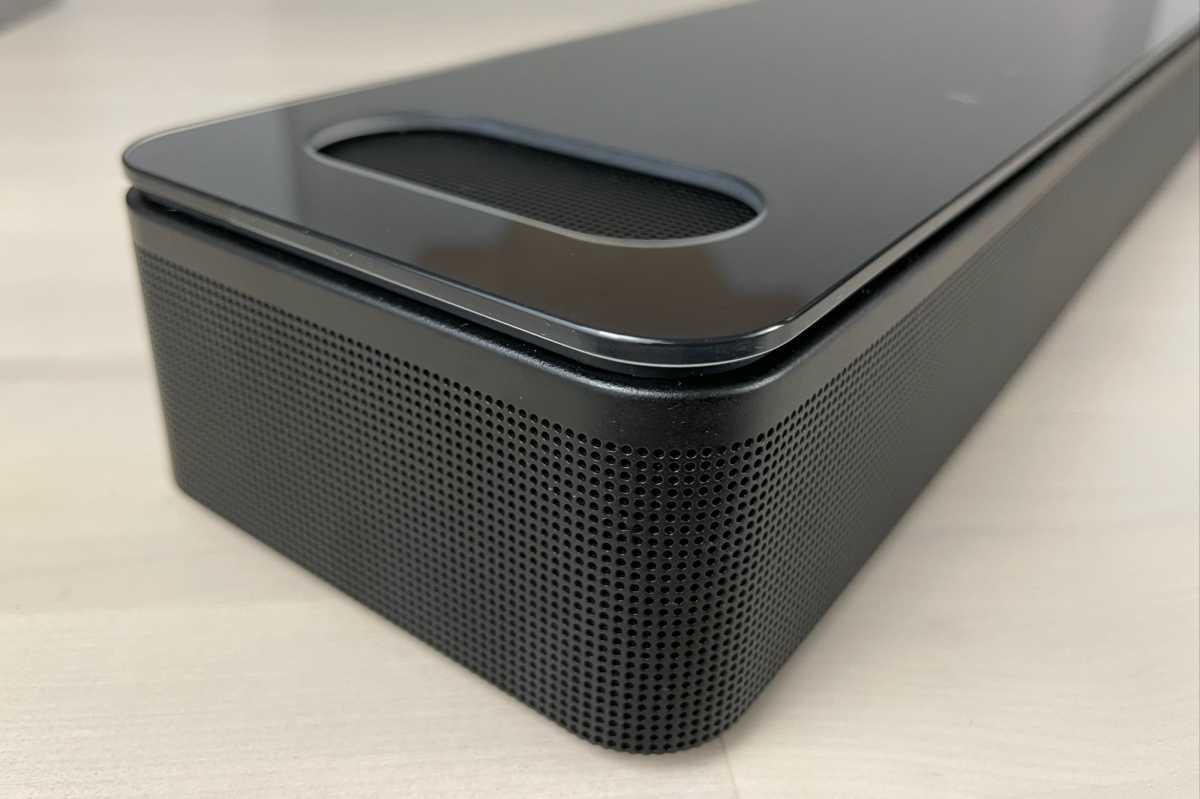
The Bose Smart Soundbar 900 comes equipped with upfiring drivers for Dolby Atmos height cues.
Ben Patterson/IDG
So, how does all that translate into a channel configuration? That’s a good question, and one that Bose seems reluctant to answer. The project page for the Smart Soundbar 900 yields no details, nor did I get a direct response from Bose following repeated queries. I could take a guess myself, but all that really matters is that the soundbar does deliver discrete left, right, center, and height channels, along with those two PhaseGuide channels that essentially act as virtual surrounds. There are no powered woofers, although ports in the back of the soundbar cabinet were clearly puffing air during big bassy moments. So, 5.0.2 maybe? Does it matter?
Whatever its channel configuration, you can upgrade the Bose Smart Soundbar 900 with additional speakers if you wish. For example, you could pump up the low frequencies with the Bose Bass Module 700 ($799), as well as add physical surround speakers with the Bose Surround Speakers 700 ($599). Springing for both the subwoofer and the surround speaker kit would bring the total price for the whole shebang to roughly $2,300–expensive, yes, but this is Bose we’re talking about. Bose also offers a step-down Bass Module 500 ($499) and Surround Speakers $399 that will work with the soundbar. Bose didn’t supply me with any extra speakers for my review.
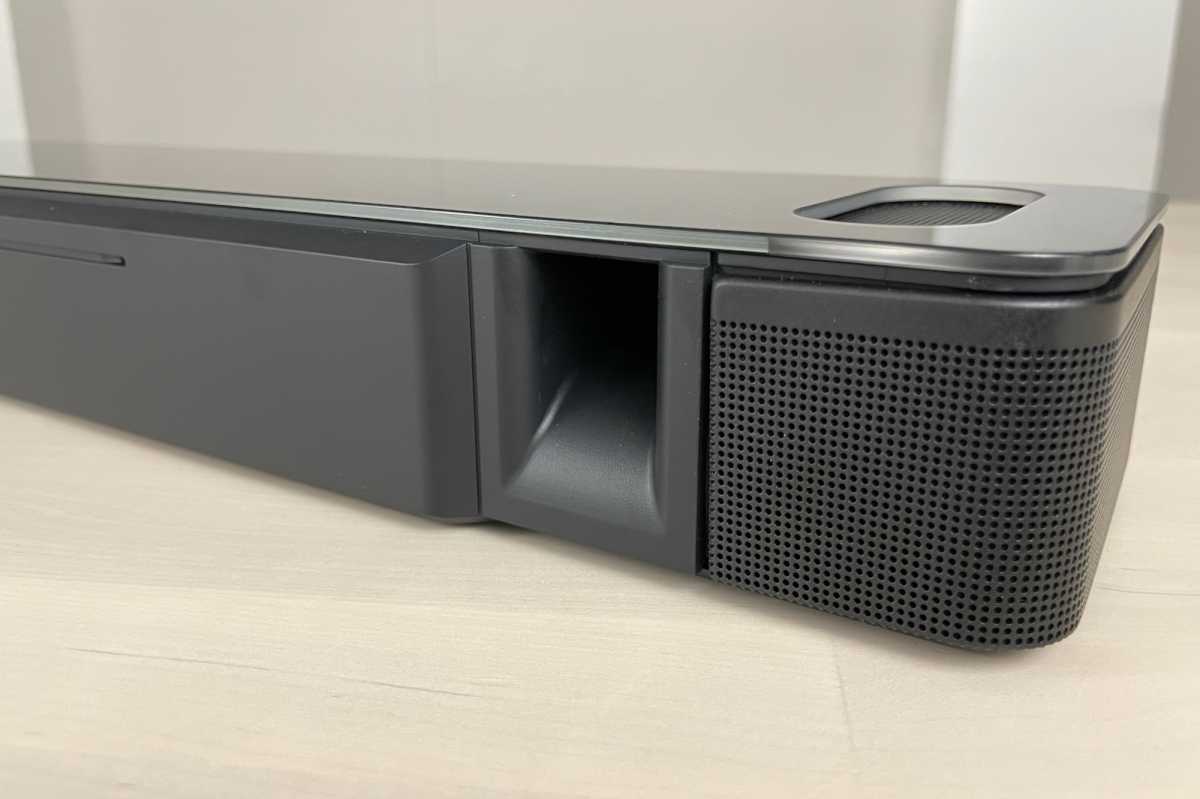
You can feel air moving out of the Bose Smart Soundbar 900’s rear ports during big, bassy moments.
Ben Patterson/IDG
Measuring 41.14 x 4.21 x 2.29 inches (WxDxH) and weighing in at 12 pounds, the Bose Smart Soundbar is slightly narrower than a 55-inch TV, with a low profile that won’t block the bottom edge of most screens when the soundbar is placed in front of a set. Besides placing it in front of your TV, you could also install it beneath your TV, but doing so requires an optional $39 mounting bracket.
The Smart Soundbar 900’s most distinctive design touch is its clear glass top (with oval openings for the upfiring drivers), which gives the speaker a decidedly premium look. That said, I found the reflection of my TV picture on the glass to be somewhat distracting, and the glass also tends to attract dust, not to mention fingerprints.
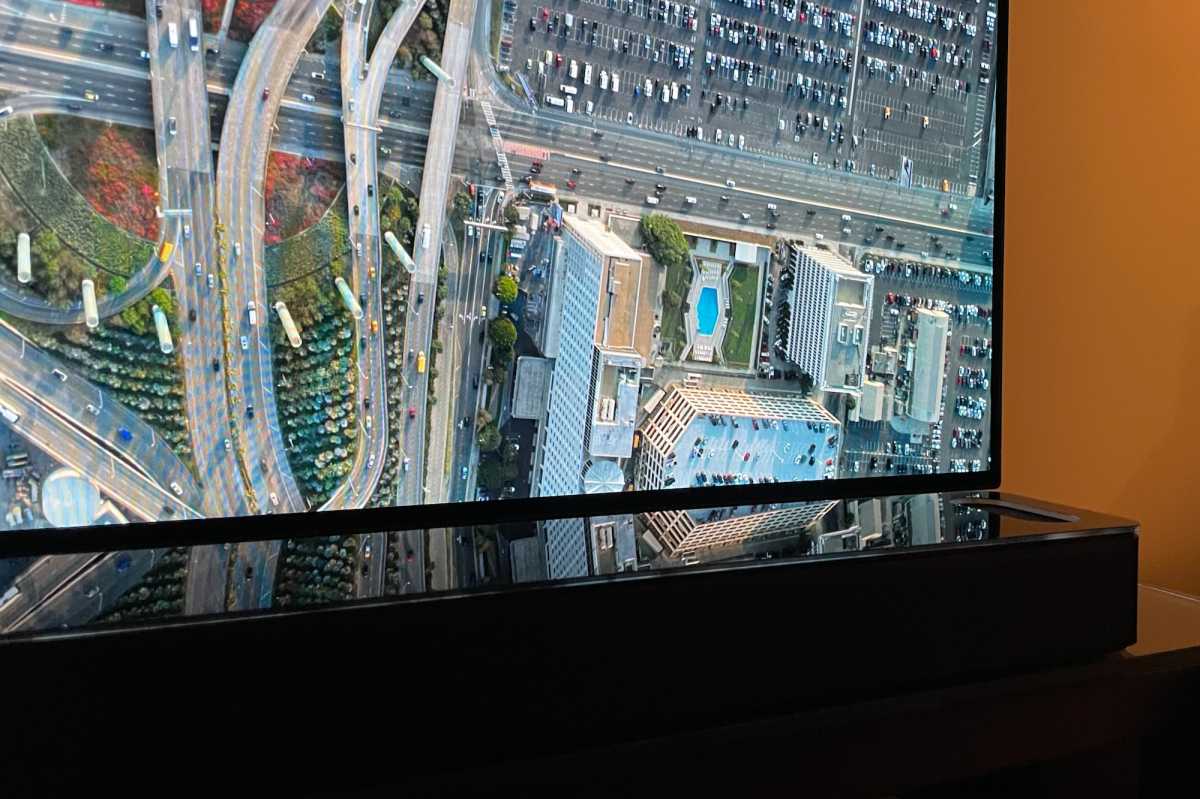
The Bose Smart Soundbar 900’s glass top is certainly snazzy, but it’s also distractingly reflective.
Ben Patterson/IDG
Inputs and outputs
The Bose Smart Soundbar 900 has only two audio connectors, which are both located in the first of its two rear cavities: an HDMI-ARC port that supports eARC (an “enhanced” version of ARC that allows for lossless audio formats such as Dolby TrueHD), and an optical (Toslink) input for legacy TVs. Because the 900 lacks separate HDMI inputs, you’ll need to connect your video sources (such as a streaming video player, a game console, and/or a Blu-ray player) to your TV’s HDMI inputs and then pipe the audio down to the soundbar, rather than connecting sources directly to the soundbar itself.

The Bose Smart Soundbar 900 has a single HDMI-eARC connector.
Ben Patterson/IDG
Besides the HDMI and optical connectors, there’s an ethernet port for wired network connectivity, plus a USB-C service port.
A second rear cavity includes proprietary data and bass jacks (the latter allows for wired connections to Bose subwoofers), a jack for an IR receiver (if you want to control the soundbar with a third-party universal remote), and an “ADAPTiQ” jack for use when calibrating the soundbar’s audio (we’ll get to that in a moment).
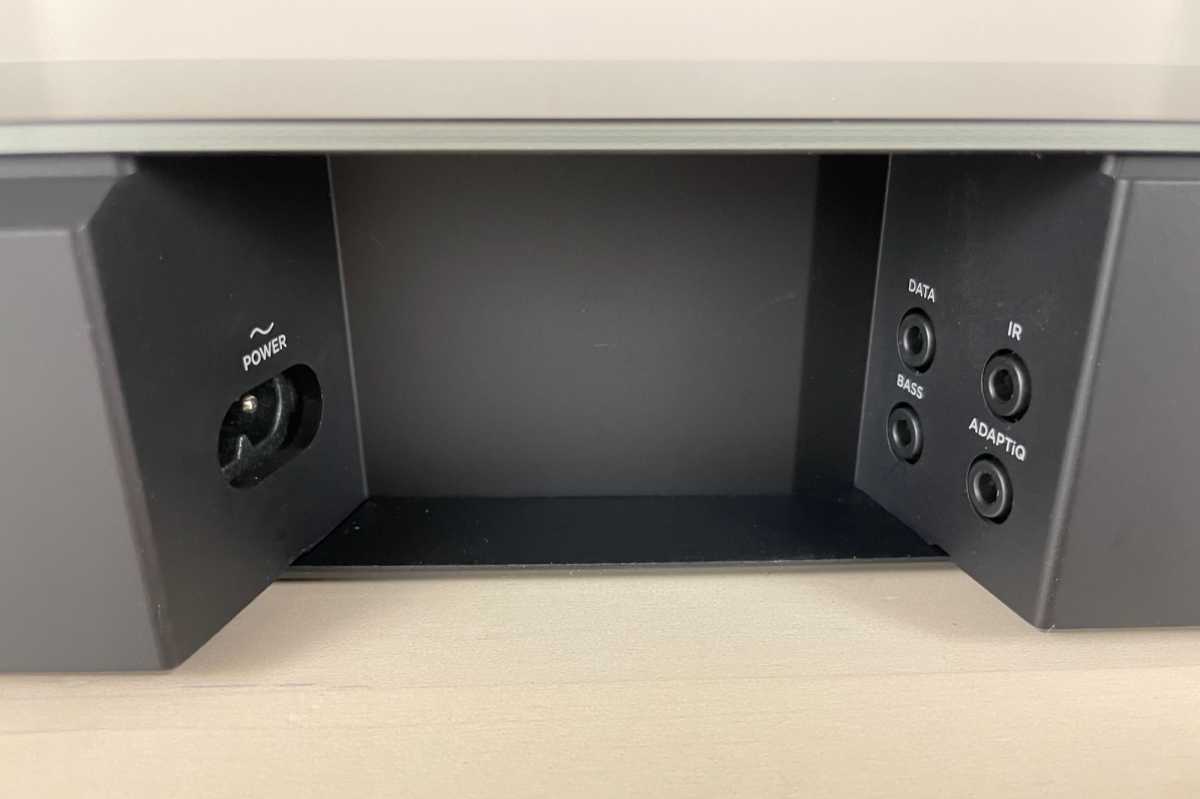
The left rear cavity of the Bose Smart Soundbar 900 has 3.5mm jacks for its ADAPTiQ room-correction headband, an IR receiver, data, and a proprietary subwoofer connection.
Ben Patterson/IDG
Setup
Getting the Bose Smart Soundbar 900 up and running takes a few steps but is a smooth process overall. Once you place it in front of (or install it below) your TV and plug it, you download the Bose Music app and either sign in or create an account (you can sign in with Facebook or Apple if you like). The app steps you through the process of adding the soundbar to the app and connecting it to your Wi-Fi network (which, for me, worked on the first try).
With the Smart Soundbar 900 connected to your home network, the app lets you sign in to one or more music services (Amazon Music, Deezer, iHeartRadio, Pandora, and Spotify are supported) before installing any available updates. The app then asks whether you’d like to connect any additional Bose speakers to the soundbar before beginning ADAPTiQ tuning, which calibrates the Smart Soundbar 900’s audio according to the acoustics of your room.
The ADAPTiQ process involves sliding what appears to be a black plastic headband onto your head; the headband is connected to a long thin cable with a 3.5mm jack that snaps into the ADAPTiQ port on the rear of the soundbar.
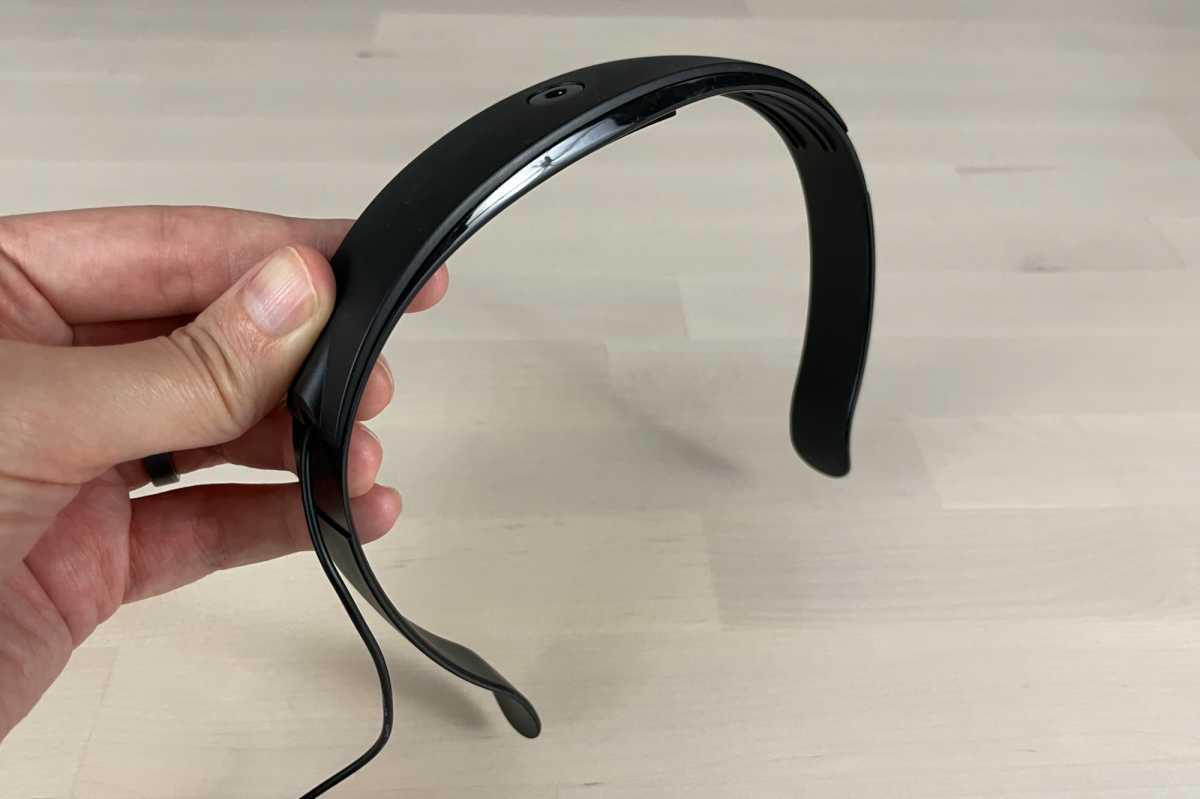
You’ll need to wear this headband during the ADAPTiQ room correction process; a microphone is embedded in the top of the band.
Ben Patterson/IDG
One you sit in your favorite listening position, the soundbar beings playing a series of beeps, blips, and deep boops, which are registered by a microphone embedded at the top of the headband; the soundbar then measures your room’s acoustics by noting how long it takes for the various sounds to reach the mic. All told, the process takes about 10 minutes.
Indicators, remote, and app control
Bose takes a minimalist approach to indicator lights on the Smart Soundbar 900, with only a thin light bar on the top-left edge of the speaker, sitting just below the glass surface. The bar pulses when you push the volume buttons on the remote (although it doesn’t give you any sign of the volume level), and it also flashes white when the soundbar is connecting to Wi-Fi or blue when pairing with a Bluetooth device.
If you’ve installed a voice assistant (more on that in a moment), the bar will turn yellow when there’s a notification, green when making or receiving a call, or purple when “do not disturb” mode is enabled. Of course, the bar will also glow when either Alexa or Google Assistant is listening or speaking.

A thin light bar glows when Alexa or Google Assistant is speaking.
Ben Patterson/IDG
The compact remote is almost perfectly flat save for the indented power and media playback buttons, along with the central volume rocker. Just below the power button are three more buttons that let you switch between music, TV, and Bluetooth inputs, while the flat Mute button might be difficult to find in the dark.
Also on the remote are six (perfectly flat, again) preset buttons that can be assigned to streaming music playlists. For example, if you’re enjoying Spotify’s Just Good Music playlist on the Smart Soundbar 900, you can press and hold the “1” button on the remote to assign the playlist to that preset. Tapping the “1” button again will make the soundbar tee up that playlist. Keep in mind, however, that the soundbar must be in music mode for the preset buttons to work, meaning that if you’re watching a TV show and try pressing a preset button, nothing will happen; you’ll need to press the Music icon on the remote first.

The Bose Smart Soundbar 900’s remote has six numbered preset buttons for streaming music.
Ben Patterson/IDG
The Bose Music app is the same one you’d use with any connected Bose speaker, and it comes with a sleek, stylish interface that’s easy to navigate. A Settings tab lets you group the soundbar with other Bose speakers (or connect a “SoundLink”-enabled Bose speaker or headphone), change the audio source, or perform some modest audio tweaks (only the center, height, bass, and treble levels can be adjusted). The Music tab allows for perusing natively supported streaming services, such as Amazon Music, Deezer, and Spotify, while a Favorites tab lets you save and edit the aforementioned remote presets for music.
Smart home and audio casting
The Bose Smart Soundbar 900 boasts both built-in Alexa and Google Assistant, although only one at a time (or neither, if you’d rather not have a voice assistant around). One you have either Alexa or the Assistant installed, you can perform just about any task that you could on an Amazon Echo or Google Nest speaker using voice commands, such as “Alexa, play some music from Spotify,” “Hey Google, turn up the volume,” or “Alexa, turn living room lights off.”
If you pick Alexa as your voice assistant on the Smart Soundbar 900, you get some added perks, such as the ability to call or “drop in” on other Echo speakers, as well make or answer voice calls. Alexa can also take advantage of Bose’s Voice4Video feature, which lets you control your TV and cable box with voice commands. For example, you could say, “Alexa, turn on the TV,” or “Alexa, watch NFL network,” or even “Alexa, next channel.” Nice, but Voice4Video only works on supported TVs and cable/satellite boxes. If you’re a cord-cutter without a cable box, Voice4Video will not control your streaming-video player, nor can it take charge of your TV’s built-in channel tuner (I tried).
While only Alexa or Google Assistant can be enabled on the Smart Soundbar 900 at any given time, the soundbar’s two supported audio-casting options–Apple’s AirPlay 2 and Google’s Chromecast–can be enabled simultaneously. I streamed audio to the soundbar via both schemes and each worked as advertised. It’s worth noting that while AirPlay 2 is enabled by default, Chromecast must be turned on manually via the Bose Music app.
Sound modes and audio features
Discussing the Bose Smart Soundbar 900’s available sound modes is easy: there aren’t any (with one small exception, which I’ll touch on in a second). That’s bad news for those who like to tinker with the Movie, Music, Sports, and Game modes on other soundbars, but good news for anyone who’d rather not bother. Instead, there is simply Bose’s own tuning of the speaker, augmented by a feature called TrueSpace that automatically upmixes non-Atmos (i.e. 5.1 and stereo) sound sources to make use of the height channels. (TrueSpace can’t be turned off, by the way.)
Now, there is one other audio mode on the Smart Soundbar 900: a dialogue mode that boosts the clarity of voices in the center channel. Unfortunately, there’s no night mode that compresses the dynamic range of the sound for late-night listening sessions.
Finally, a note about DTS. Like other recent soundbars, the Bose Smart Soundbar 900 ships without a DTS decoder. That means if you’re watching a Blu-ray with a DTS-HD Master Audio soundtrack, you’ll need to offload the DTS decoding to your Blu-ray player or TV, and then send the audio to the soundbar in PCM format.
Performance
I won’t keep you in suspense: The Bose Smart Soundbar 900 arrives with excellent sound, refined, silky, and–characteristically for Bose–sensible. This isn’t a soundbar that attempts to wow you with jaw-dropping surround effects or big, boomy low-frequency effects. In other words, the Smart Soundbar 900 has an audio signature that’s more of a velvet glove than a punch in the face.
On the flip side, the surround and height effects on this Bose soundbar never quite blew me away, with the height cues generally sounding restrained and the overall soundstage focused on the front and center. No doubt a pair of surround speakers would tease out the surround effects, while you could always nudge the height channel settings from the Bose Music app. It’s also worth noting that all-in-one soundbars that employ DSP to push the immersiveness often add harsh, hissy audio artifacts in the process; however, the Smart Soundbar 900 never exhibited that problem.
Playing the UHD Blu-ray of Star Wars: The Empire Strikes Back, I enjoyed the crisp, musical sound of John Williams’s memorable soundtrack, while the snowspeeders zipping around the lumbering Imperial Walkers sounded smooth and supple (if such could be said about clanking four-legged war machines). Dialogue was always clear, and there was even some palpable bass from the roar of the Millennium Falcon’s engines as it corkscrewed away from a trio of Star Destroyers.
As I just mentioned, however, the overall soundstage felt front-focussed, with little in the way of surround effects. Height cues were subtle but noticeable (the hiss of snow falling from the crumpled ceiling of the Rebel base wasn’t as evident as I’ve heard on other Atmos soundbars), and the sound didn’t feel hugely dynamic to my ears. In short, the sound I did hear from the Smart Soundbar 900 was excellent, but it wasn’t as immersive as I’ve heard on competing all-in-one-soundbars. Adding a Bose subwoofer and surround modules could solve that issue.
Switching to the UHD of Apollo 13 (a movie with a DTS:X soundtrack, thus I set my Blu-ray player to PCM output), the thrilling launch sequence accompanied by James Horner’s rousing score was a pleasure to listen to, even if the virtual surround effects didn’t blow me away. The rumble of the Saturn V’s engine was deep but not boomy, and as with Empire, I never had trouble hearing the dialogue. I was particularly struck by the beautiful, ethereal music as the weightless astronauts removed their gloves and helmets just after the launch. Simply gorgeous.
Returning to Dolby Atmos with my UHD of Blade Runner 2049, I dialed up the scene when K’s spinner is fired upon by scavengers on the ground. The pitter-patter of rain on the spinner’s windshield is catnip for Atmos height cues, but on the Smart Soundbar 900 the effect was somewhat subdued, as was the whiz of the incoming fire. When K’s disabled spinner slams into the ground, the crunch of rocks and debris sounded detailed and full-bodied, but again the soundstage felt focused on the screen rather than enveloping the room.
I also tried 1978’s Superman on iTunes, which now boasts a restored Dolby Atmos soundtrack. Musically, the opening title sequence sounded great, with decent if not room-shaking bass. The Atmos and surround cues on those zooming title cards were somewhat subdued, but the “whooshes” never sounded hissy or shrill either, a problem on many other all-in-one Atmos soundbars I’ve tested.
For music, I began with Bruce Springsteen’s “The Ghost of Tom Joad” on Spotify, and while the soundstage on the track felt a bit narrow, I loved the timbre of The Boss’s voice and the reediness of his harmonica; the recording felt thrillingly alive. For “Oxytocin,” the Smart Soundbar 900 delivered Billie Eilish’s breathy, seductive vocals with finesse, although the drivers labored a bit with the big bass line. Vlado Perlemuter’s performance of Ravel’s solo piano works for Nimbus felt atmospheric and nuanced rather than mushy, while Chet Baker’s “Solar” might be the ideal demo track for the soundbar, with terrific presence and pop.
Bottom line
So, should you buy the Bose Smart Soundbar 900? I’d say yes, but only if you’re open to adding more speakers. That’s a pricey proposition, but Bose isn’t exactly a budget brand, so look elsewhere if you’re trying to keep your costs down. If you are ready to open your wallet, you’ll be dipping into a top-notch ecosystem with a soundbar that (aside from that missing DTS decoder) packs more features than you can shake a stick at.

